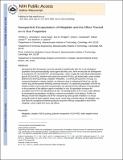Nanoparticle Encapsulation of Mitaplatin and the Effect Thereof on In Vivo properties
Author(s)
Kulak, Nora; Pridgen, Eric M.; Farokhzad, Omid C.; Lippard, Stephen J.; Johnstone, Timothy; Langer, Robert S; ... Show more Show less
DownloadLippard_Nanoparticle encapsulation.pdf (3.294Mb)
PUBLISHER_POLICY
Publisher Policy
Article is made available in accordance with the publisher's policy and may be subject to US copyright law. Please refer to the publisher's site for terms of use.
Terms of use
Metadata
Show full item recordAbstract
Nanoparticle (NP) therapeutics have the potential to significantly alter the in vivo biological properties of the pharmaceutically active agents that they carry. Here we describe the development of a polymeric NP, termed M-NP, comprising poly(d,l-lactic-co-glycolic acid)-block-poly(ethylene glycol) (PLGA-PEG), stabilized with poly(vinyl alcohol) (PVA), and loaded with a water-soluble platinum(IV) [Pt(IV)] prodrug, mitaplatin. Mitaplatin, c,c,t-[PtCl[subscript 2](NH[subscript 3])[subscript 2](OOCCHCl[subscript 2])[subscript 2]], is a compound designed to release cisplatin, an anticancer drug in widespread clinical use, and the orphan drug dichloroacetate following chemical reduction. An optimized preparation of M-NP by double emulsion and its physical characterization are reported, and the influence of encapsulation on the properties of the platinum agent is evaluated in vivo. Encapsulation increases the circulation time of Pt in the bloodstream of rats. The biodistribution of Pt in mice is also affected by nanoparticle encapsulation, resulting in reduced accumulation in the kidneys. Finally, the efficacy of both free mitaplatin and M-NP, measured by tumor growth inhibition in a mouse xenograft model of triple-negative breast cancer, reveals that controlled release of mitaplatin over time from the nanoparticle treatment produces long-term efficacy comparable to that of free mitaplatin, which might limit toxic side effects.
Date issued
2013-05Department
Massachusetts Institute of Technology. Institute for Medical Engineering & Science; Massachusetts Institute of Technology. Department of Chemical Engineering; Massachusetts Institute of Technology. Department of Chemistry; Koch Institute for Integrative Cancer Research at MITJournal
ACS Nano
Publisher
American Chemical Society (ACS)
Citation
Johnstone, Timothy C., Nora Kulak, Eric M. Pridgen, Omid C. Farokhzad, Robert Langer, and Stephen J. Lippard. “ Nanoparticle Encapsulation of Mitaplatin and the Effect Thereof on In Vivo Properties .” ACS Nano 7, no. 7 (July 23, 2013): 5675–5683.
Version: Author's final manuscript
ISSN
1936-0851
1936-086X